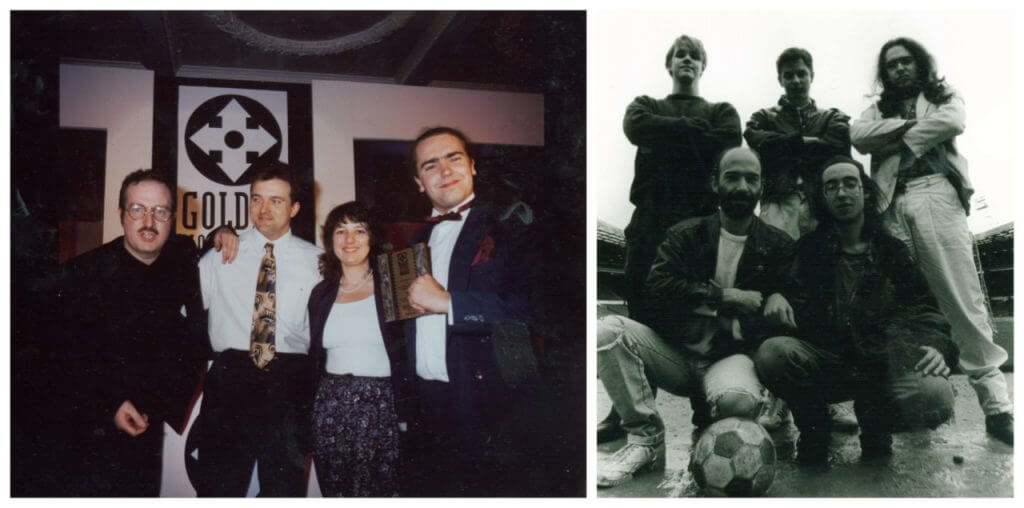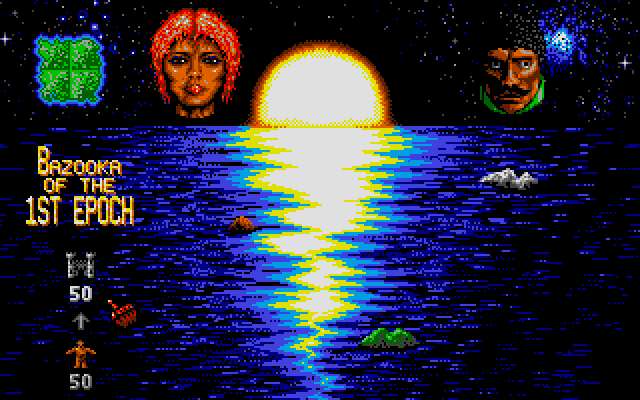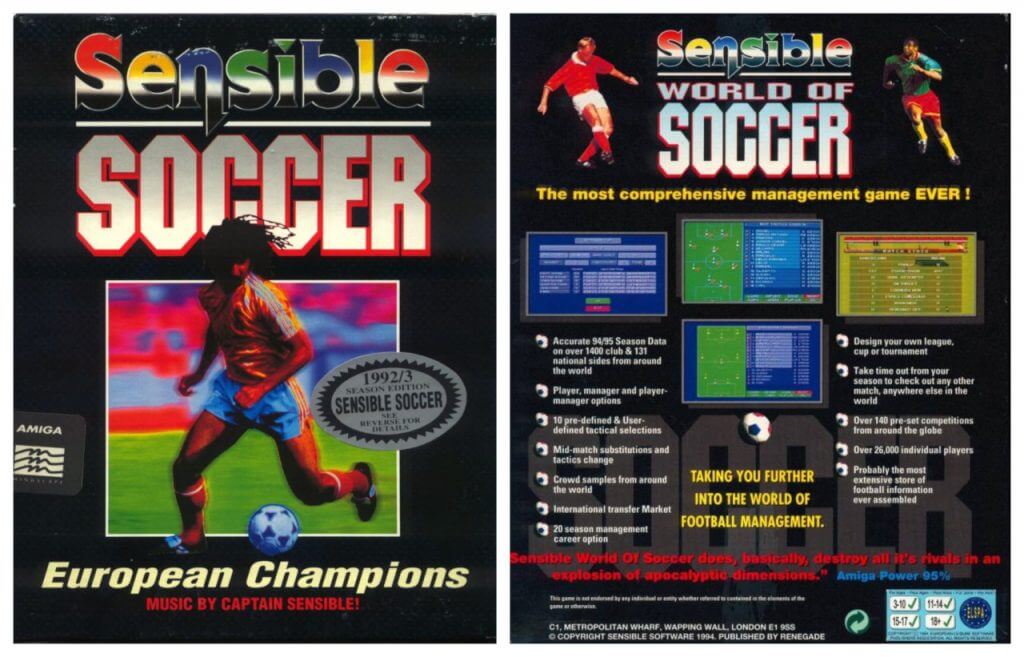You lost Martin Galway in 1990 when he departed to work at Origin Systems.
We lost Martin and we lost Touchstone as a game. I put about a year into that, which is a bit depressing.
But soon after you secured another legend, Richard Joseph, who’d become more than an adequate replacement for Martin in the music and sound department. It must have been an incredible experience to work with such talents. You and Richard were known to collaborate a lot musically over the years to come, so what’s the story of Richard’s Sensible marriage?
Well, we met Richard, I think, when we did SEUCK. Because he was working with Palace at the time, on Barbarian if I remember rightly. He was Palace’s main sound man. Although we didn’t work directly with Richard on the SEUCK, because it didn’t need sound. But we went back to Palace to do International 3D Tennis – the game we did after Microprose Soccer – and Richard was the guy to work with. Martin had just left and, as you rightly say, we totally fell on our feet. Considering me and Chris are both musicians, we luckily managed to work with two musical geniuses on our games – pretty much all the time at Sensible. We couldn’t have had two better guys and their style, I think, sometimes it just clicks. What we were good at was steering the ship ourselves but allowing other people to add their personality to the work, and with Martin and Richard that really is apparent. You can’t argue that on some of the C64 stuff, Martin’s work is the standout work. In terms of Parallax, it definitely is for example.
Richard was different to Martin. Martin, who at 18 years old, was a young whizz-kid type of character, whereas Richard was the opposite. He was older than us; he was about 12 years older than me. He had a recording contract with EMI, I think it was, when he was in his 20s. And by his own admission, he had been too far up his own ass and pretentious to understand what was going on and actually blew it, which he was trying to forgive himself for. He was hanging out and associated with some very successful people like Trevor Horn, Shaq Attack and other successful musicians that he’d been working in and around with. He comes from a highly musical and media family. His father was a film producer who worked with the Alfred Hitchcock. His older brother is a big deal in film sound. His younger brother runs The Mill, which is a big post-effects house in London that does Doctor Who and various other shows. His nephew also does a lot of film sounds himself; he has done Harry Potter and James Bond and stuff like that.
Considering me and Chris are both musicians, we luckily managed to work with two musical geniuses on our games – pretty much all the time at Sensible
Richard comes from a very rich media family in the UK – and by rich, I mean steeped in experience. So he kind of chose games, in a way I’m guessing, to individualize himself from his brothers. He brought this savvy film stroke music business world to us. He was very experimental and he had ambition.
Can you give an example?
The next game we were doing was 3D Tennis and we had commentary in it by Dan Maskell, who was the BBC commentator for a tennis in the UK. He was the voice of tennis on our television. He also brought the TV theme, so we recreated the structure of the BBC TV theme tune as our tune for 3D Tennis.
Yet still, 3D Tennis is a virtually unknown game, despite also utilizing 3D vector graphics and having a pair of ridiculous stickmen chasing the ball on the court…
With 3D Tennis it was simple; Chris just wanted to do 3D on C64. It’s worth talking about the game a bit as it was important in the evolution of the company. It was the first time we reconstructed an entire sport in a game. Although it looks a bit weird and most people don’t know about the game. It was actually our first game we did also for 16-bit machines, because we did it cross-platform. It was the first time we successfully employed another programmer do anything because we got David Korn – also called Ubik – to do the conversion to the 16-bit platforms for us. And it was the first time that I had designed a game with a full sports world behind it – although the funny little stickmen look ugly, I normally say like Czech cartoon characters from the ‘70s, because they do. They were really Boris Becker and Stefan Edberg. We had every top player in the world in the game. You played a full career and you had to go through your season, working out which tournaments you wanted to play. We emulated accurately the professional tennis tournament prize money for the entire year. That preceded what we did with Sensible Soccer. Maybe people don’t know that, but for me as a designer it was a very important part of the learning curve.

Nonetheless, the next game in the pipeline was a real-time strategy for 16-bit computers. Mega-lo-Mania, published in 1991, at first glance seemed like a take on Bullfrog’s Populous or Powermonger. The game had a few revolutionary features for a 16-bit real-time strategy game. It was packed with some cool elements such as catchy voice-overs and a research technology tree. It also introduced players to a hilarious mini-sprite character art style that became something of a signature in your subsequent titles. All that neatly packed on, what, two floppy disks? I remember playing it a lot back on Amiga, so I am very eager to finally hear about its story.
The story of how that game was made is pretty crazy. We hadn’t employed anyone to work as a programmer on an original game before. Chris had always been the original programmer for everything we’d done. But when we came to make Mega-lo-Mania, we wanted to see what it was like to get another programmer to come in, because we realised that I didn’t have time to do art for two games at once. The games were taking a year and a bit to make in general. We wanted to make a space exploration game, so we made this game where you flew a spaceship around and there were 16 planets you could land on, then you could mine there, make better weapons for your spaceships and upgrade them. There’s a little castle there where you can breed men and then decide whether you want them to fight or stay there and do stuff. The game was like that for a year and we pitched it out to Virgin and various other companies.
Then about six months before the end of it, we still hadn’t signed a deal. At that point, I saw the advert for a Populous or Powermonger with the cavemen. Just the advert, didn’t see the game. The game had already been made – the whole thing with tech trees and stuff was already there – but it was bloody hard to play. Flying a spaceship plus not getting killed, plus doing all the stuff you do in Mega-lo-Mania at the same time, was humanly impossible really. So we decided to ditch the spaceship and then we didn’t know what to do. Then I saw the caveman and thought, why don’t we, rather than starting in 10 000 AD and getting better and better spaceships and going forward, why don’t we start in 10 000 BC with the cavemen? Then go through the tech tree but in known technologies. From cavemen up to biblical times and Roman times, then medieval times, Victorian times, WWI and II and spaceships and nuclear weapons, etcetera. Yeah, it worked. We then had to humanize the tech levels, which is when you get the little men coming up to represent these different historical periods of time.

It’s quite intriguing to realise that you played, perhaps even coincidentally, such an important role in this freshly emerging genre of computer game. How successful was the game after its launch?
A number of games came out. Dune II [1992] had come out around about the same time. What I’m saying is that us developers, we were making games without really knowing what each other were doing at the same time. It was really because the 16-bit machines allowed us to explore more – they had more memory and better graphical capabilities – so we could do more. We all seemed to gravitate to different versions of the same thing. So our focus was on tech trees, quite fast gameplay, very mouse-driven gameplay. It was a men-management game basically; there’s time and men assignment. Then you layer on top of that Richard’s great work on the speech, some really good music, the humor again with the characters. I really love Mega-lo-Mania. It really suffered because of stuff outside of our control. It was a number one game. I think it came out in about October or September ‘91, and it was really going places. Then unfortunately, Mirrorsoft, the company we signed up with, just went bust two months after the game’s launch.
Ouch…
We got no royalties from it and it killed the game just as it was rising. It was a bit of a blow, because I think the game would’ve done well. Probably with a bit of a push, it would have done better in the States, and as it was, it didn’t really get that kick at the right time. It needed to get bigger, but it got smaller. Six months later we re-signed it to Ubisoft, but the momentum had gone then.
That’s a shame. However, speaking of publishers in general, it’s quite interesting to note that throughout the whole Sensible era, you were very flexible with them – something almost unheard of these days.
Well, it is for better business. You’ve got to remember – like I’ve said to you before with Ocean – all of their artist statements said zero at the bottom. You need to put this in perspective. We did three games with Ocean: Parallax, Wizball and Wizkid – we haven’t talked about Wizkid yet. That’s three with Ocean. We did two with Palace: SEUCK and International 3D Tennis. We did two with BT: Oh No and Galaxy Birds. We only did one with Microprose because they were not nice to work with. That’s the main reason we only did one with them; they weren’t a nice company to work with. Although they they did pass the money, they made things very difficult for us. Then with Mirrorsoft, although we only did one game with them, we had actually signed on four, but they went bust.
What we learnt was that you need to retain your relationship with publishers and have good working relationships, but also you need more than one source of income. Because if anything goes wrong with that company, your company goes down. Actually, what we learnt from the Mirrorsoft experience was that we signed four games with them, they went down, and we were in trouble and lost 75 percent of our turnover that year. That nearly killed us. So yeah, we didn’t move around as much as it appears. Companies were offering you deals to secure your future, while you commit everything to them for that time.
The first ever game was Norwich vs Sunderland, it was obviously a lot of fun
Mega-lo-Mania, Mega-lo-Mania 2, Sensible Soccer and Cannon Fodder were all signed with Mirrorsoft when they went down. They also had a lot of Bitmap Brothers games signed, Probe games and many other companies. I think they’d signed up over half of the talent in the UK, so it was a big big deal for everyone when they exploded.
In 1992, an immediate hit that rippled through the fabric of space-time was born. In the years to come, it received many reiterations and conversions, and its legacy lives on in the hearts of many devoted gamers. Sensible Soccer was the single most important title that made you the rockstars of the game industry – well, at least in Europe. A lot was written and said about it and even people who don’t normally enjoy football enjoyed the game due its pace, ease of controls and excellent multiplayer. Still, I wonder whether there is something left out; anything you have never revealed about this game before?
Sensible Soccer is the only game I worked on that, within two months, you knew it was gonna be a hit. It just played so well. We played it non-stop in the office ourselves. You have the ability to colour in the little men, who were just the Mega-lo-Mania men on a football pitch, with your football kit. I was a Norwich fan and Jools – who was the Cannon Fodder programmer at the same time – was a Sunderland fan. The first ever game was Norwich vs Sunderland, it was obviously a lot of fun and we were really enjoying it.

I don’t know what to say that maybe no one knows. I think that what we really learnt with Sensible Soccer, was how people fill in the the gaps that they don’t see. So, literally, when the guys are running around the pitch, it’s only three frames of animation – a left leg forward, a right leg forward and both these in the middle. But people imagine them chesting the ball down or doing little spins. When we see something in the distance, the brain fills in gaps. That’s how the human mind works. So what we really learnt with SS is that the graphics, when you look at them, still aren’t that great, but when they’re moving, they play tricks with your mind and make you think that there’s more going on than there is. Layer on top of that that we were the first game to have Black players or even players with blond hair, to use shirt numbers to identify who the player was, or to have all those teams from all over the world. Sensible World of Soccer (SWOS) has 1500 teams and 23,000 players – from memory. Sensible Soccer was less, it was about half or maybe a third of that, but still a huge volume of a world of football.
It is no coincidence that we were one of the first games to ever include anything from the Czech Republic (Czechoslovakia) in it. And not just the Czech Republic (Czechoslovakia), but also Poland, Argentina, Yugoslavia, South Africa, etcetera. These countries were ignored by the gaming world and we embraced them.